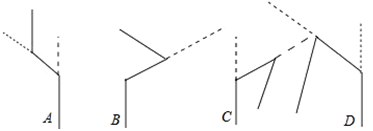问题
选择题
某人在广场上练习驾驶汽车,两次拐弯后,行驶方向与原来相同,这两次拐弯的角度可能是( )
A.第一次左拐30°,第二次右拐30°
B.第一次右拐50°,第二次左拐130°
C.第一次右拐50°,第二次右拐130°
D.第一次向左拐50°,第二次向左拐120°
答案
答案:A
题目分析:两次拐弯后,行驶方向与原来相同,说明两次拐弯后的方向是平行的.对题中的四个选项提供的条件,运用平行线的判定进行判断,能判定两直线平行者即为正确答案.
如图所示(实线为行驶路线):

A符合“同位角相等,两直线平行”的判定,其余均不符合平行线的判定.
故选A.
点评:平行线的判定和性质是初中数学的重点,贯穿于整个初中数学的学习,是中考常见题,一般难度不大,需熟练掌握.
